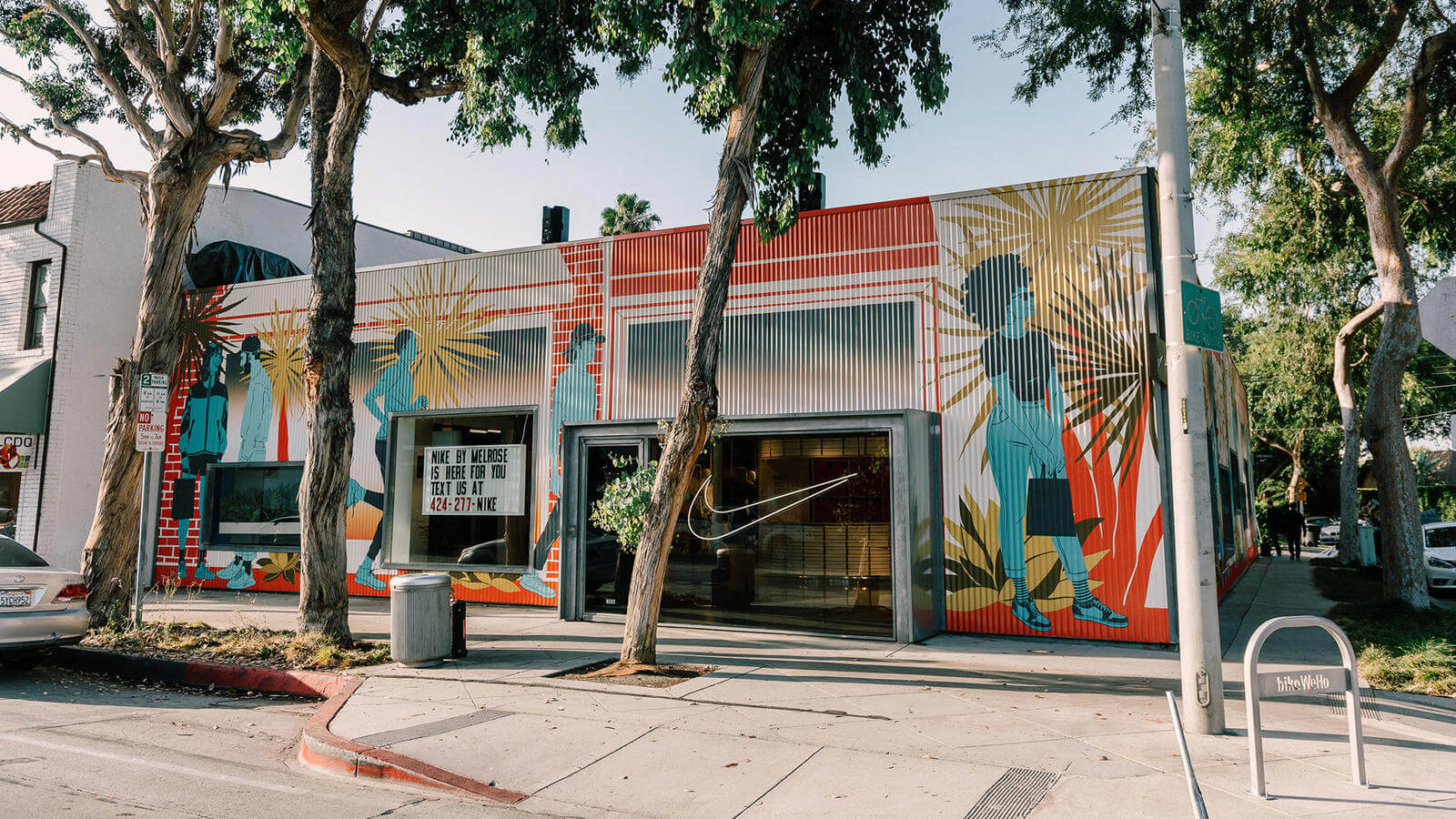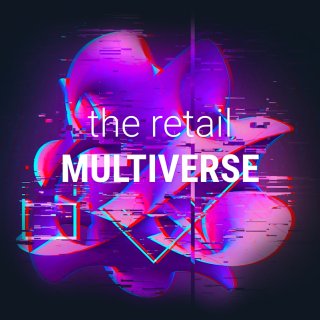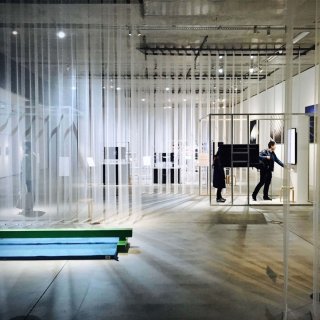
curate a lifestyle – what your customers value most
Four trends determine the shopping of tomorrow
„Love this store…. The staff are great! They know what I like and upon arrival will direct me to the stuff they picked out for me. I have the best time there “
This is one customer review for Nike by Melrose in Los Angeles. This store shows what other retailers can’t yet do: the entire site is geared towards walk-in customers in the neighborhood. Customers can try out precisely those products in-store that are most frequently requested by the local clientele. Bestsellers can be found quickly and easily. There are also trend areas with new products that could be of interest to customers and that perfectly reflect their lifestyle. Everything is connected with mobile technology. Reserving shoes online and retrieving them from a locker in the store that can be opened with an app is not a vision of the future, it’s reality. Customers pay for and pick up their purchases using their cellphone. Owing to the lack of parking spaces in the vicinity, there’s also a type of drive-through. And if you’re coming to the store to try out and experience classic products, you can order a personal shopper in advance.
Nike is thus reflecting several current retail trends that have arisen due to customer expectations:
Relevant and local – the best in shop design
Do all the stores in a chain really have to look the same? Do customers in Hamburg city center buy exactly the same products, displayed in exactly the same way, as customers somewhere in the country? That’s actually not very likely.
An Australian agency has developed a vision of the future in which the customer opens a store with his customer card and the interior of the store changes completely in that moment. It will be adapted precisely to the customer’s taste and style, with special highlight products being selected and displayed. We don’t have to go quite that far, but the expectation is there. Studies show that 45% of shoppers have difficulties finding what they need and love online. How can companies make this easier for their customers? The Israeli start-up Mystore-E, for example, has developed screens that can identify customers’ gender and style of dressing as they walk past in the store and can provide them with customized suggestions based on this.
Shopping becomes fun when the store is able to make a relevant, personalized preselection. It’s better to have a smaller selection that is targeted towards what the customer is really looking for. The clothing brand Massimo Dutti offers a “see now buy now” function, where an app displays favorite items discovered while out window shopping on a Sunday directly on the customer’s screen, allowing the customer to order them for home delivery.
Convenient and easy – mobile first
The tech giants Amazon and Alibaba are leading the way. In particular, they want to make buying “standards” – everyday products that are purchased regularly – quick and easy. Customers no longer have to wait in line at the checkout to pay, but instead use a mobile app, a fingerprint or facial recognition. “Pay with a smile” is the advertising slogan used by KFC in China. Saturn is trialling checkout-less stores in Germany, while Apple has had these for a long time already. However, there has not yet been widespread acceptance here. This is partly because registration processes are too complicated, while fears of abuse are too high and cash payments are still commonplace.
In China, on the other hand, the trend has exploded like a bomb. People are even said to be deliberately moving into areas around Alibaba’s Hema supermarkets so that they can get fresh food ordered via an app delivered within 30 minutes. Meanwhile, Alibaba’s rival Super Species is experimenting with deliveries by drone, to reduce this time frame to 15 minutes.
Sustainable and conscious – focusing on humans and the environment
The Fridays for Future activists have initiated a change in thinking, consciously instigated by Generation Z, also known as Gen Z: people currently under 20 years of age. They can’t remember a time without smartphones and have grown up with an awareness of global developments from the beginning. Gen Z currently represents 30% of the global population. It will soon account for the largest share of consumers, and these people know how much influence they have. Not just through their own spending power, but also because they are changing their families’ behavior, for example by explaining at the dinner table at home how plastic waste can be avoided on an ongoing basis or how the family can purchase more food produced locally. They prefer brands that act in an ethical and environmentally conscious way and are concerned with sustainable products and production conditions. The spectacles manufacturer VIU (fair prices combined with a transparent manufacturing process) and the fashion brand Everlane place a lot of emphasis on transparency in the manufacturing of their ranges. Their websites disclose how the price of a product is calculated and which factories are used for production. These are signs of how image and attitude interact.
Personal and “social” – recommendations will decide
Even if Gen Z has grown up in a mobile world, 80% still enjoy browsing in stores. Here, the focus is on the experience, on being able to touch the products and on personal interaction. Digital interfaces with the store, also known as touchpoints, are less relevant. Why should they use a large touchscreen that is publicly visible when they have their smartphone on them to look up prices or find information?
What’s more important is that everything works smoothly in the store, as if customers were making a “one-click” purchase online. When it comes to human interaction, on the other hand, customers are divided.
Some are delighted when everything works easily without any contact with sales staff, for example via a chatbot; “Lemonade”, a US-based insurer, is becoming particularly popular at present. The bot guides customers through the complicated process of taking out an insurance policy with very simple questions. Services can be booked or canceled, policies taken out and claims reported with a click. According to a study by Forbes, bots will take over up to 90% of human interactions in the purchase process within the next five years. This can work so well because the conversation with the bot, although digital, will feel like highly personalized advice.
However, the personal touch is exactly what is particularly important to all other shoppers and is why they go to physical stores. It’s the people on site who make the difference. Like Petra Krämer at the Hugo Boss store in Munich’s “Fünf Höfe” [“Five Courtyards”] shopping mall, who receives a lot of regular customers. Her customers particularly value her honest opinion: if Ms. Krämer does not recommend the suit, it won’t be sold. Ms. Krämer is thus subconsciously deploying one of the most modern sales strategies of all, focusing not on one-off sales but instead on long-term customer satisfaction. If the customer does not make a purchase today, it’s not really relevant. The advice provided in-store was so good that he will return and will recommend Ms. Krämer.
If Ms. Krämer gave shopping advice through social media, she would be an influencer with an unbelievable ability to attract customers. The right influencers are those who can provide a massive boost to spending power through social media. One example is the sports goods manufacturer Gymshark, which specializes in functional yet stylish outfits for the fitness studio. It initially got bodybuilders to wear its clothing and later extended this to Instagram fitness stars. In doing so, it hit a nerve within the online community: real people in authentic situations, using the product honestly and thus creating trust.
Curate a lifestyle
These individual retail trends should not be regarded as separate or conclusive; they always overlap and are constantly evolving. They will have a lasting influence on the future of shopping in the next five years. At rpc, we’re looking every day at innovations and future developments in retail. New technologies and digitalization are continually offering new opportunities, irrespective of how big the company is or which sector it operates in. Not everything is always suitable for mainstream use, but time and again they offer opportunities for growth.
It’s important for businesses to understand that there is no way back – the train will keep moving. However, the good thing is that you can climb on board and become a part of it at any time, adapting to the customer and evolving with the customer. Creating surprisingly good services for customers again and again and inspiring them. The options are many and varied and the potential is huge. Now is the time to do something with it.
This article was also published on https://www.eyebizz.de.
Picture: Nike by Melrose in Los Angeles, nike.com








